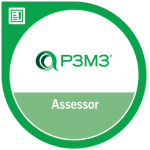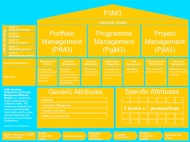Introduction
As HWP Consulting, we introduced in 2014 a Project Success Scan and we collected data points of more than 200 companies (see Project Success Scan). In 2017 we became an accredited AXELOS Consulting Partner for the P3M3 Maturity Model.
Many organizations are using traditional project management as well as agile delivery frameworks and in my opinion it’s not that black or white, you have to choose, depending on the change initiative, the right framework to make the change happen and that can contain traditional as well as agile flavors. When we look at the current P3M3 v3 model, I have problems to incorporate the agile way of working. E.g. how to cope with a permanent agile team?
In this article, I am proposing an extension of the P3M3 model to incorporate this agile way of working and I am looking forward to your feedback. At the end of the article there is a link to a very small questionnaire, which I hope you can complete.
Before I go into my proposal a short overview of the existing P3M3.
P3M3
At this moment AXELOS offers P3M3 version 3.

To download: P3M3 V3 (QRC, 171205) v1.0
P3M3 version 3 contains three models, reflecting portfolio (PfM3), Programme (PgM3) and Project (PjM3) Management. We see seven perspectives applicable within each of the models:
- Organizational Governance: Why we want to do what projects / programmes / portfolios
- Management Control: Verifying that projects / programmes / portfolios progress as planned and within their authority
- Benefits Management: Ensuring / proving our projects / programmes / portfolios are / were worthwhile doing in the eyes of the stakeholders
- Financial Management: Getting and managing the money to do it
- Stakeholder Management: Involving those who care and those who need to care
- Risk Management: Managing uncertainty
- Resource Management: Making sure we have the capacity to deliver
P3M3 can be used independently of your chosen project, programme or portfolio management method or framework.
The model is based on the five known maturity levels:
- Level 1 : Awareness of process
- Level 2 : Repeatable process
- Level 3 : Defined process
- Level 4 : Managed process
- Level 5 : Optimized process
When answering questions you have the option to answer level 0: Unaware too.
New, in comparison with the previous version, are the max. 13 threads: Asset Management, Assurance, Behaviors, Commercial Commissioner, Commercial Deliverer, Information and Knowledge Management, Infrastructure and Tools, Model Integration, Organization, Planning, Process, Standards and Techniques. The most detailed questions are now the diagnostic attribute statements.
You can perform, by yourself, a Standard self-assessment or Enhanced self-assessment (subscription). The latter offers you on top of the standard self-assessment a maturity tracker, detailed results and a benchmark.
It is also possible, via an accredited consulting organization (e.g. HWP Consulting) to perform a full accreditation assessment resulting in your maturity level based on P3M3 or a full further diagnostic assessment including an improvement plan to achieve the next maturity level.
Agile extension
Additional model: Permanent agile team
If you are using permanent agile teams (e.g. in your Software development department) the model will not help you to measure the maturity of these teams. Within the P3M3 model we have PfM3 for portfolio management (permanent organization), PgM3 for programme management (temporary organization) and PjM3 for project management (temporary organization). I added a fourth model PtM3 for Permanent agile teams.
 As the three other models, this PtM3 model uses the same five levels. These five levels can be described as follows:
As the three other models, this PtM3 model uses the same five levels. These five levels can be described as follows:

In the current P3M3 model we have seven perspectives. If your organization is using an agile way of working this will have consequences for your assessment of portfolio, programme and project management too. To cover this, I added an eighth perspective: Agility.
Additional perspective: Agility

At portfolio level your strategy must show agility, at programme level you must have agility within the strategic objective, at project level you must have agility at the project product level and within the permanent agile team you must have agility at product level (satisfy customer, prioritization, maximizing the amount of work not done).
The three tables provide an overview of the high level descriptions for the Agilty perspective in the three Management Maturity Models.



The next table provides an overview of the high level descriptions for all eight perspectives in the new Permanent agile team Maturity Model.
 To download: PtM3
To download: PtM3
Additional thread: Product
 To download: P4M3 overview
To download: P4M3 overview
To emphasize the importance of the product, I added an additional thread: Product. In this thread the maturity of the following attributes will be measured (source: Agile enterprise agility): Shippable, Cycle time, Product vision, Stories INVEST compliant, Definition of Ready (DoR), Definition of done (DoD), Story size, Backlog refinement, Slicing, and WIP.

To download: Thread product
Closure
HWP Consulting, as an Accredited P3M3 Consulting Organization can help you in performing a P3M3 full accreditation assessment or full further diagnostic assessment including an improvement plan based on your own objectives. To avoid bias we can facilitate your self-assessment as well. For the agile extension we developed the 3 reflective statements (organization, process, performance) for each of the eight perspectives within the Permanent agile team Maturity Model too. Feel free to get in contact.
Please fill in this simple questionnaire to help me to improve this P3M3 Agile extension.

 As a consequence of receiving the P3M3 Assessor badge from AXELOS after I passed for the P3M3 Consultant examination, I had to update my P3M3 QRC to correspond with the latest P3M3 version.
As a consequence of receiving the P3M3 Assessor badge from AXELOS after I passed for the P3M3 Consultant examination, I had to update my P3M3 QRC to correspond with the latest P3M3 version.




















